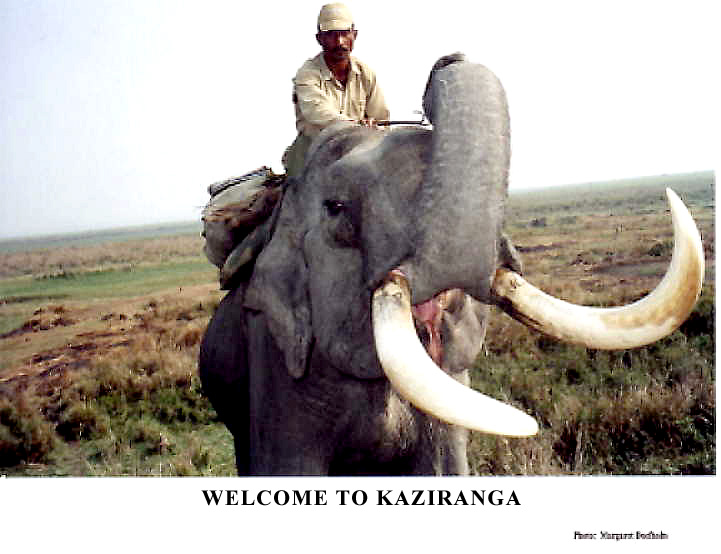KAZIRANGA'S WILD KINGDOM
By Margaret Deefholts
Traveller's Voice Magazine
Travel Writers' Tales

From
where I sit perched on my elephant howdah, the Kaziranga National Park is a
stretch of wild grassland fringed by marshland and thick jungle. The mahout
nudges me gently and points. Fifty feet away, small ears flicking, and horns
pertly upturned like inverted commas, two one-horned rhinos stand face to face
as if in conversation. One of them turns its head and peers short-sightedly
at us through little piggy eyes. I freeze and so does our elephant. Rhinos are notoriously unpredictable and
have been known to charge with amazing speed despite their tank-like size. But
perhaps camera-toting tourists have become a ho-hum sight these days, or the
wind has changed direction. Either way, the rhinos lose interest in us and lumber
off in the direction of a muddy watercourse.
Located
in Assam, in the northeast corner of India, the 430-acre Kaziranga Park is a
rare success story in the annals of animal conservation. Other than the Chitwan
Reserve in Nepal, Kaziranga (declared a national park in 1974) is the only place
in the world
where one-horned rhinos(Rhinoceros Unicornis) are still in existence. Although they remain an endangered species, they were on the verge of extinction thirty
years ago having dwindled down to less than 200 animals in both India and Nepal.
Today, the rhino population in Kaziranga hovers around the 1700 mark. Even so
the battle against poachers is far from over. Rhino horn-actually a spike of
hardened hair-is reputedly an aphrodisiac and, as a powder it sells for about
$40,000 per kilo.
The
dawn is misty until an enormous, blood-orange sun emerges suddenly over the
horizon. A swamp deer with curving antlers leaps across a field and for an instant
is silhouetted against the sun like a black cardboard cut-out. The breeze carries
the tang of marshland, and as we emerge from a thicket of twelve-foot high spiny
grass, we catch
sight of a herd of wild elephants about a hundred yards away wallowing in the
mud. A mother playfully squirts her baby with a stream of water. Engrossed in
their morning toilet, they ignore us.Not
so a family of wild buffalo. They have a calf in their midst and the male lowers
his head
and tosses his horns. Our elephant hastily backs away.
An estimated 53 tigers also prowl through Kaziranga, but are tough to spot as they blend in with the tall, tawny grassland. The mahout shakes his head when I ask him about the possibility of a sighting. "Not here," he says emphatically. "The jungle is filled with calls of alarm when a tiger is around." Although no alarms are sounding, the morning is anything but silent : a cloud of chittering mynah-birds swerve and scatter overhead and the whoop of a langour monkey floats across to us from beyond a fringe of trees.
Later
that day Palesh, a young man with an encyclopaedic knowledge of Kaziranga's
bird population, takes me on an open-roof jeep along rutted jungle paths. "Stop!
Stop!" he commands the driver at intervals, and points out the flash of
a small blue kingfisher, a pompous-looking spotted owlet and shoals of partridge.
An egret rides on the back of a rhino, and nesting lesser
adjutant
storks regard us with hauteur. Kaziranga boasts approximately 480 species of
birds, some of which are migratory, and in a ninety-minute drive we spot at
least 40 varieties-crow pheasant, red-breasted parakeets, a racquet-tailed drongo
and a Pallas fishing eagle, to name just a few.Back
at the Wild Grass Resort I sit in the garden by the swimming pool. As dusk falls
crickets shrill in the hibiscus bushes and an Indian Koel bird sends its plaintive
cry across the lawns-a harbinger of summer. The sunset sky is streaked orange
and purple. Tomorrow I will be back amid the seething crowds of Mumbai-but will
carry with me memories of emerald parrots, petal-eared rhinos and the eerie
yowl of jackals under the full moon.
IF YOU GO:
Getting There:
The
nearest airport is Jorhat (96 km), but Guwahati (239 km) has a better choice
of flights from Kolkata (Calcutta) and Delhi. State transport buses also ply
to Kaziranga, but the quickest and most convenient method of travel is by tourist
taxi.
Accommodation:
Kaziranga
offers a range of rest houses, lodges and dormitory accommodation, maintained
by the Forest Department and the Department of Tourism. Bookings need to be made several months in advance by writing
to the Joint Director of Tourism, Kaziranga, P.O. Kaziranga National Park, District
Jorhat, Assam, India 785612.
The upscale Wild Grass Resort, set in a delightful tropical garden, with
well appointed suites, and excellent cuisine. They offer a Jungle Plan
per person, per day which includes meals and elephant safari & jeep trips
through the Park.
Contact:
Manju Baruah,
Phone : 91-361- 2546827 or 91-361-2630465
Deepak (mobile 94350-48403) (Manju Barua)
mobile 9954416945
Phone 91-3776-262085
Wild Grass (Guwahati)
Barua Bhavan, 40 M C Road Uzanbazar
|
|
|
Best time to Visit:
Between November and April. Kaziranga virtually closes down during the monsoon months of June-September, when the lowlands are subject to heavy flooding. The winters November - February are cool and require light woolens. March and April are steamy.